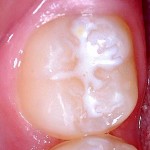
Previous reviews have clearly demonstrated the effectiveness of fissure sealants in preventing caries. However there has been discussion as to whether their performance is affected by different tooth types. In addition, recent guidelines has called for more studies on the their use in the primary dentition.
The aim of this review was to assess the clinical performance of sealants on various teeth.
Methods
Searches were conducted in the Medline, Scopus, Web of Knowledge; Virtual Health Library, Google Scholar, International Standard Registered Clinical/ soCial sTudy Number registry, Directory of Open Access Journals, Digital Dissertations, and metaRegister of Controlled Trials. The Reference lists of included trials were also manually searched. Randomised clinical trials (RCT) on humans including at least one trial arm comparing clinical performance of pit and fissure sealants with any other active, control, or placebo were considered.
Two reviewers independently selected studies abstracted data and assessed risk of bias using the Cochrane tool. The primary outcome was dental caries of the sealed tooth, secondary outcomes included combined (total or partial) loss of the sealant, total loss of the sealant, need for re-sealing, and replacement of the initial sealant by a restoration. Relative Risks (RR) and their corresponding 95% Confidence Intervals (CI) were calculated. Statistically significant results of binary meta-analyses were translated clinically using the Number Needed to Treat (NNT). Random effects meta-analysis was carried out using the Paule and Mandel model. Overall quality for the main outcomes was assessed using the GRADE system.
Results
- 16 RCTs involving a total of 2778 patients were included.
- 3 studies were parallel design 13 cluster design.
- None of the studies was at low risk of bias, 9 studies were at high risk of bias the remainder at unclear risk.
- For caries incidence in sealed teeth
- No significant differences could be found between teeth on the right or left side of the mouth and between maxillary and mandibular teeth.
- Compared to sealed first permanent molars, sealed premolars were significantly less likely to develop caries (3 trials; RR = 0.07; 95% CI = 0.01 to 0.61; P = 0.013)
- Sealant retention
- No statistically significant difference in combined loss of the sealant could be found according to mouth side (right versus left side), jaw (upper versus lower), and tooth type.
- However, sealants on 1st or 2nd premolars were significantly less likely to be lost compared to sealants placed on 1st permanent molars (7 studies; RR=0.42; 95% CI=0.21 to 0.83; P = 0.013).
- The quality of the evidence supporting all the comparisons as assessed using GRADE was very low to low.
Conclusions
The authors concluded: –
the performance of pit and fissure sealants in terms of caries of the sealed tooth or retention loss of the sealant do not seem to be negatively affected by mouth side, jaw, and tooth type. The only exception was the use of pit and fissure sealants on premolars, which was associated with lower sealant failure rate compared to the use of pit and fissure sealants on the first permanent molar, indicating favourable performance. From the perspective of the sealant’s clinical performance all deciduous or permanent posterior teeth could be effectively sealed.
Comments
Cochrane reviews continue to demonstrate the effectiveness of fissure sealants in caries prevention and the latest update (Dental Elf – 31st July 2017) included 38 studies in total. For this review only 16 RCTs could be included providing very low to low quality evidence related to the various outcomes addressed. Several meta-analyses were conducted comparing caries experience and sealants loss with some of these only involving a small number of studies. Given the limited number of studies and the low overall quality of the studies involved. It is possible that further high-quality research might result in changes to the findings that there is no apparent affect related to tooth characteristics.
Links
Primary paper
Papageorgiou SN, Dimitraki D, Kotsanos N, Bekes K, van Waes H. Performance of pit and fissure sealants according to tooth characteristics: A systematic review and meta-analysis. J Dent. 2017 Aug 8. pii: S0300-5712(17)30198-7. doi:10.1016/j.jdent.2017.08.004. [Epub ahead of print] Review. PubMed PMID: 28797916.
Other references
Original review protocol on PROSPERO
Dental Elf – 31st July 2017
Fissure sealants effective in preventing caries in children and adolescents
